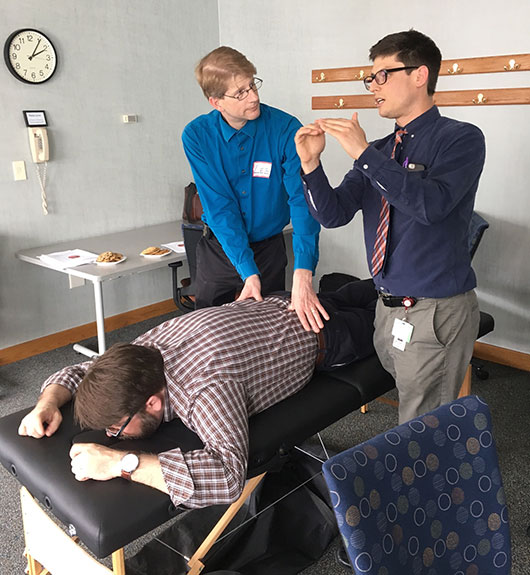Thank you for your interest in our OMT for the MD curriculum. We are excited to offer our blended on-line/in-person curriculum for use at your institution. This course was created with the busy resident physician schedule in mind and can be delivered longitudinally.
Background
The philosophies of osteopathic medicine and family medicine are inherently harmonious. Both seek to treat the whole person (body, mind, and spirit) while respecting the self-healing capacity of each individual. Osteopathic theory and practice are based on the core concept that alterations in physical structure affect physiologic functioning, and vice-versa. By addressing these physical alterations (ie somatic dysfunctions) OMT aims to correct aberrant physiology. OMT is indicated in many common primary care clinical scenarios. This elective is designed for allopathic residents who desire an in-depth training in osteopathic manipulative diagnosis and treatment.
Objectives
The physicians who completes this pathway will learn to:
-
- Appreciate the historical context and evolution of osteopathic medicine and its role in today’s health care system.
- Apply osteopathic principles and clinical reasoning to formulate appropriate osteopathic treatment plans for common presenting conditions.
- Become proficient at performing an osteopathic structural exam, including segmental diagnosis of the axial and appendicular skeleton.
- Become proficient with a range of OMT modalities, including soft tissue, counterstrain, muscle energy, and myofascial release to treat somatic dysfunctions of the axial and appendicular skeleton and related soft tissue.
- Appreciate the role lymphatics and autonomics play in the application of osteopathic clinical theory and use OMT to address somatic dysfunctions that impact the normal physiologic functioning of these systems.
- Effectively document and bill for osteopathic diagnosis and treatment.
Curriculum
What we provide:
-
- 8 modules complete with on-line lectures
- Lab outlines (for both facilitator and learner)
- Reading list
- Procedure log form
- Final evaluation exam
Local program requirements:
-
- An anatomy reference
- A local facilitator to lead the in-person hands-on lab portion
- We also recommend scheduling the learner with a physician that does OMT to gain additional practice and confidence in their OMT skills.
Student requirements:
-
- Purchase/Access to textbooks
- Osteopathic Techniques: The Learner’s Guide by Gustowski, Budner-Gentry, and Seals (ISBN-10: 162623425 / ISBN-13: 978-1626234253)
- Recommended purchase for individuals
- Basic Musculoskeletal Manipulation Skills: the 15-minute Office Encounter by Rowane and Evans (available through AAO)
- Recommended local program copy available for individuals to reference
Cost: $500/per academic program initially and $100 maintenance fee annually
Complete this form for Enrollment »


